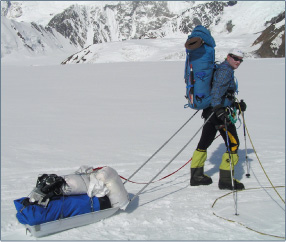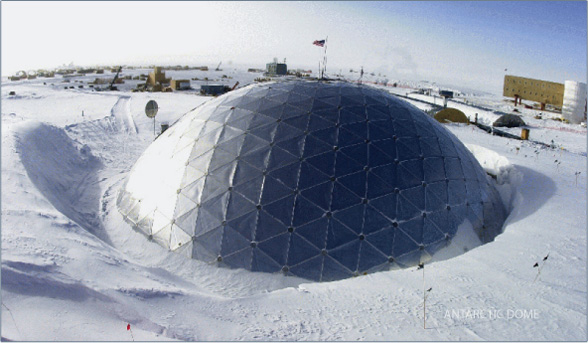|
|
|
| |
|
|
| |
As opposed to The Arctic, which is an expanse of
ice at sea level, The Antarctic is not only much colder, but is even
studded with mountain ranges with glaciers, crevasses and continuous ups
and downs. Moreover, the Geographic South Pole is at 3.000 meters: and
this means more extreme temperatures (about one degree every 100 meters
of drop) and less oxygenation.
The Antarctic is considered the hardest desert on
the earth, without vegetation and with a percentage of oxygenation below
the average.
This, despite good athletic preparation and a good
season, will make the expedition more complex and will test their
abilities.
All these factors, together with the logistic
difficulties, have always made the South Pole less attractive even for
the professional climber. |
|
| |
|
|
|
|
|
| |
|
|
| |
 |
It will be a slow
and hard advance, towing sledges and carrying rucksacks full of heavy
things: Tents, sleeping bags, airbeds, camp equipment, supplies and
overall gas.
Of course, it may seem strange, but without gas
(about 40 kg) there is no possibility of survival.
With gas you melt the snow to drink the water (4
or 5 litres a day), you cook, and maybe you can also warm yourself.
Because cold and wind will be the worst obstacle. Gusts of about 100 km
per hour could sweep the glaciers lowering by several degrees the
temperature, from the real to the perceived one (statistically it has
been calculated in one degree every 10 km per hour). The weights at the
beginning will be between 80 and 90 kg for each person: a great deal,
although still less than what was used for the Mc Kinley approach, when
even the complete alpinist equipment had its weight. |
|
|
| |
|
|
|
|
|
| |
|
|
| |
Days will roll by slowly, without darkness, step
by step for about 8/10 hours a day before the stop to prepare camp,
pitch the tents, build the walls to protect tents from the wind, cook
the dinner and finally enjoy the deserved rest. And then it is time to
take down the camp, reassemble the equipment and restart… And so for
days, crossing uncontaminated and breathtaking sceneries in absolute
peace, till they reach the desired goal: AMUNDSEN-SCOTT’s base with the ANTARCTIC DOME,
the semi sphere shaped like a mirror, symbol of the South Pole. From
there a flight, that will also take home some of the researchers, which
will bring them to Patriot Hills and then to Punta Arenas in Chile. |
|
| |
|
|
| |
|
|
| |
|
|
| |
 |
|
| |
|
|
| |
|
|
|
